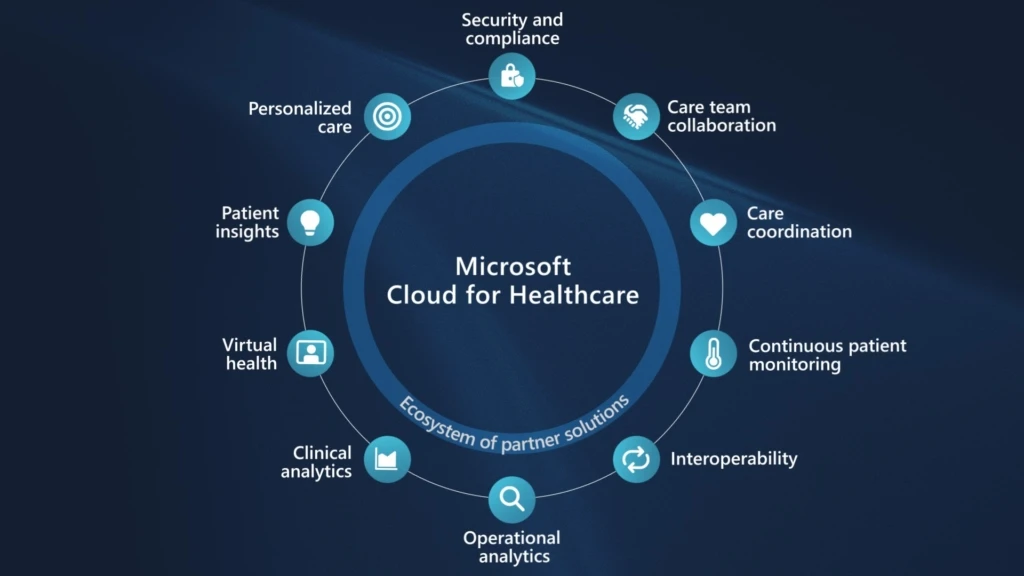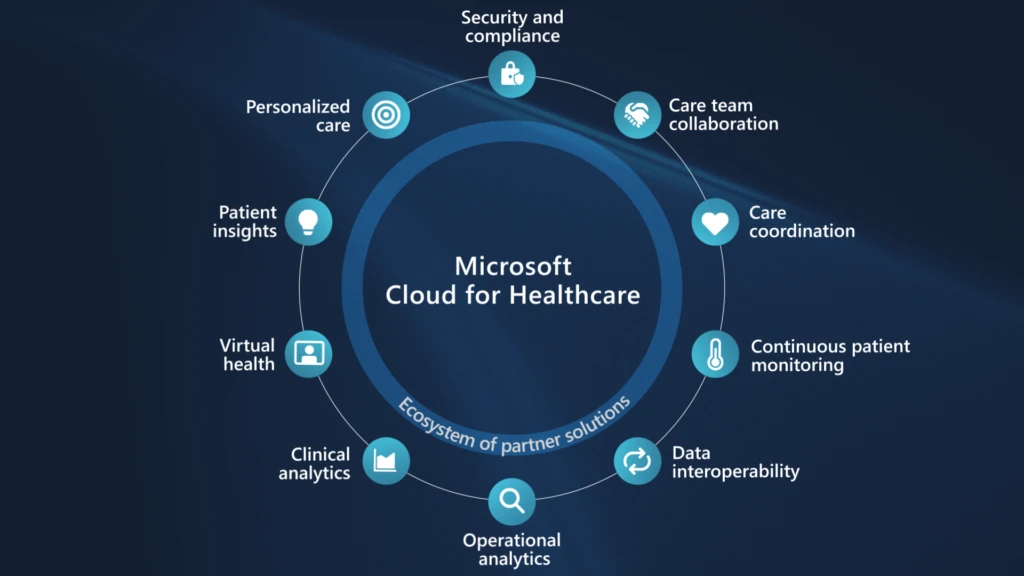
Creating a resilient patient-centered healthcare system

Microsoft is helping organizations set a course for recovery and resiliency in an ever-changing healthcare environment. At Microsoft Ignite, we’re announcing the general availability date for Microsoft Cloud for Healthcare and revealing more enhanced capabilities that help organizations adapt to the disruption, and build scalable modalities of care while safeguarding patients, care teams, and assets—the keys to making healthcare more accessible, efficient, and affordable—for all.
Microsoft Cloud for Healthcare is how Microsoft, and our partner ecosystem, helps healthcare organizations re-imagine tomorrow: by empowering everyone to deliver value faster, to make more impactful decisions to set a clear course for the future, and to adapt and transform with boundless agility. We’re helping shape and scale digital health capabilities that empower healthcare organizations to get inspired with insights, tools, resources, and rapidly build solutions to drive better experiences, insights, and care.
I’m pleased to announce that Microsoft Cloud for Healthcare will be generally available on October 30, 2020, including managed services designed to support healthcare organizations. This integrated solution enables customers to quickly access a portfolio of released and new healthcare capabilities tailored to the unique requirements of health data in the cloud. It unlocks the power of Microsoft Azure, Microsoft 365, Microsoft Dynamics 365, Microsoft Power Platform, and our ecosystem of partner healthcare solutions to create trusted end-to-end cloud-based solutions. Healthcare organizations can engage in more proactive ways with patients and give caregivers tools to improve data interoperability, workflow efficiency, and streamline interactions.
“There are a couple areas where I believe cloud technology for healthcare like Microsoft’s can play a critical role in a future that’s based on digital technologies, both focused on interoperability. The first is interoperability between systems, allowing us to take data from health records and other data sources, over FHIR interfaces, and combine it together into a single place where it can be used to inform and deliver patient-centric care. The second is to enable real-time complex deep learning by normalizing data from different systems in a way that allows complex algorithmic analyses to occur via AI or ML, and integrate research-based insights back into a clinical workflow.” Matt Kull, CIO, Cleveland Clinic
Enhance patient engagement
Since the beginning of the COVID-19 pandemic, patients’ demand for digital health solutions has grown exponentially. More than ever, being connected is critical to creating an individualized patient experience. Patients are actively seeking digital tools that allow them to be seen by their health provider without leaving their homes. Healthcare is going through rapid change and the focus on improving long-term patient outcomes and experiences is growing.
Healthcare systems and providers across the world are under pressure to create a future where patients are engaged in their own healthcare, clinicians can securely access patient information and knowledge that enhances their clinical practice, and the health system is integrated, high performing, and sustainable.
Microsoft Cloud for Healthcare will help organizations transform and enhance patient engagement by providing proactive ways to deliver a seamless care experience and help to improve workflow efficiency. The general availability release will provide the following new capabilities:
- Patient 360 based on HL7 FHIR: health providers can get full context into the patient’s history and their current encounters, conditions, procedures, and appointments, all fed from the EMR data repository, all built in healthcare common data model, based on HL7 FHIR with direct integration to the Azure FHIR service.
- Patient engagement with powerful insights: use real-time data to build personalized patient outreach programs that create proactive care experiences.
- Patient access to healthcare on their terms: create unique, omnichannel patient experiences and engagements for self-scheduling appointments, physician searches, proactive wellness outreach, care reminders, and online interactions with care agents, patient portals, or virtual health bots.
- Care coordination and care management: maximize the value of care being delivered by helping care teams create actionable insights across care plans and interactions with individual patients, that ensures the patient’s needs and preferences are known and addressed.
- Home health support: offer a broad range of medical care and support services by optimizing resource management, planning, and health team efficiency to assign the right health care worker to fit the patient’s needs.
Chief Information Officer of St. Luke’s University Health Network Chad Brisendine, shared his thoughts on Microsoft Cloud for Healthcare. “We’ve been using Microsoft products like Teams, Dynamics 365, Power Apps, Power BI, and Azure for a while now. We’re excited about Microsoft Cloud for Healthcare because it will bring together all of these solutions into a connected, robust experience for our frontline workers—empowering our care teams while protecting patient privacy.”
Using Microsoft Cloud for Healthcare organizations can engage in more proactive ways with patients, streamline communications, enhance care coordination, and improve health team efficiency and productivity. “At this time in history, it’s so important to have a cloud environment that endeavors to improve patient care, improve experiences for patients and the healthcare providers, and better engage patients all the way around. With interoperability of healthcare data being so important and a willingness to adopt digital health experiences, this is the perfect time for Microsoft to deliver their Cloud for Healthcare.” – Lynne Dunbrack, Group VP for IDC Public Sector, IDC
Empower health team collaboration
Providers need tools to help their clinicians provide the best possible care. We continue to expand Microsoft Teams capabilities to Microsoft Cloud for Healthcare that connect and empower care teams to securely collaborate and communicate, helping clinicians and administrators perform their jobs more effectively. We just announced the general availability of Teams templates that can help enable teams to start collaborating quickly with the right set of channels, tabs, apps, and settings that can be catered to their specific industry and scenario.
We are continuing to invest in solutions that leverage Teams to meet the unique needs of the healthcare industry. We’re making virtual care easier with the Microsoft Teams EHR connector, now in preview. This connector will allow clinicians and patients to launch Teams virtual visits right from Epic’s patient and provider portals. We also have a rich set of APIs to allow for Teams integration into other existing healthcare workflows.
Virtual visit experiences on mobile have been streamlined. Patients will soon be able to receive a text confirmation of their appointment, a reminder, and a link to join. With Mobile WebRTC, patients no longer even need to install an app on their device for the visit.
Care team collaboration has also gotten easier with Lists in Teams, giving the entire care team a smart tracking system to huddle and collaborate on their patients. They can run processes like multi-disciplinary team meetings, discharge planning, rounding, nurse huddles, and more.
According to a recent McKinsey & Co. report, healthcare providers reported 50 to 175 fold increases in telehealth patient volumes since the onset of the pandemic. This demonstrates the potential for telehealth services to improve care access and quality, patient outcomes, and healthcare system efficiency. The report urged healthcare providers to act now to scale the use of highly secure, workflow-integrated telehealth technology, incorporate virtual visits into the continuum of care, and expand services to more patient encounters and medical specialties.
To transform provider and patient experiences during virtual visits, Nuance Communications Inc. and Microsoft announce the integration of the Nuance Dragon Ambient eXperience™ (DAX™) with Microsoft Teams.
This integrated solution:
- Synthesizes physician-patient conversations during virtual visits conducted on Microsoft Teams while physicians remain focused on the patient instead of a computer keyboard.
- Integrates patient data with contextual information from the electronic health record (EHR) to auto-populate a complete and highly accurate clinical note for physicians to review directly within the patient’s medical record.
“The dramatic growth of telehealth represents a unique opportunity to use Nuance DAX ambient clinical intelligence technology to transform healthcare experiences and define what healthcare providers and consumers should expect from advanced digital health solutions. Our strategic partnership with Microsoft, which lead to this rapid integration of Nuance DAX with Microsoft Teams for telehealth, illustrates the ongoing importance of combining our technologies, domain expertise, and market reach to develop advanced cloud-based conversational AI solutions that keep the health of clinicians and patients front and center in healthcare delivery.” Diana Nole, Executive Vice President, and General Manager of Healthcare, Nuance
The Nuance DAX solution was innovated by Nuance and Microsoft, and this new integration into Microsoft Teams is part of both companies’ ongoing partnership to accelerate the adoption of ambient clinical intelligence (ACI) and to further improve healthcare experiences and reduce administrative workloads to help promote clinician wellness.
Improve clinical insights through FHIR, IoT, and DICOM interoperability
FHIR (Fast Healthcare Interoperability Resources) is rapidly becoming the global interoperability standard for secure and private exchange of health data. The Azure API for FHIR and the suite of tools like the HL7 FHIR Converter and Tools for Anonymization provide a powerful foundation in Microsoft Cloud for Healthcare to organizations with a trusted pipeline to ingest, manage, and persist protected health information (PHI) data in the cloud.
However, true interoperability in healthcare means enabling all kinds of healthcare data—not just those coming from clinical records. We’ve strengthened Microsoft Cloud for Healthcare with the Azure IoT Connector for FHIR to bring data from medical devices, apps, and remote monitoring scenarios into FHIR. In our continued efforts to expand the ecosystem of FHIR, we’re excited to bring the newly announced open-source software Medical Imaging Server for DICOM into Microsoft Cloud for Healthcare. This open-source offering allows health organizations to easily ingest and persist medical imaging files in the cloud, and integrate imaging metadata with clinical data in a FHIR format. It’s an exciting new tool for developers in building longitudinal patient health records. Read more about the Medical Imaging Server for DICOM and how it is helping enable new opportunities in AI/ML and research.
How Microsoft Cloud for Healthcare comes to life
Microsoft Cloud for Healthcare comes to life through the combination of what Microsoft and our rich partner ecosystem are doing to build, extend, and connect patient and care team experiences across the cloud. Our healthcare partner ecosystem does this in five key ways:
- Build: by building new or updating existing SaaS or other applications for specific healthcare systems or at scale using Microsoft Cloud for Healthcare as a platform.
- Extend: embedding cloud capabilities and features such as the Microsoft Healthcare Bot or Azure API for FHIR within the partners’ applications or platforms.
- Enrich: building healthcare vertical-specific applications for Healthcare Providers, Payors, or Pharma and Med Tech on Microsoft Dynamics 365, Microsoft 365, Microsoft Power Platform, and Microsoft Azure.
- Connect: using APIs, connectors, or extensions to connect and drive interoperability between Microsoft Cloud for Healthcare and the partner’s developed solutions.
- Enable: drive functional implementation of Microsoft Cloud for Healthcare including customization aligned to each customer’s needs and business processes, cloud interoperability across the customer’s systems, and services for data governance, adoption, and use.
We’re continuing to expand and support our robust ecosystem of healthcare partners who can provide solutions that complement and extend Microsoft Cloud for Healthcare core capabilities. Using these partners’ expertise will help organizations through EHR and platform integrations, implementation services, and healthcare SaaS offerings.
This global crisis has now forced payors, providers, patients, and other health stakeholders to stress-test digital modalities of deploying healthcare. Microsoft Cloud for Healthcare’s connected cloud is designed to address that need—enabling organizations with the speed and agility to adjust to change, build resiliency that help them weather today’s challenges so they can begin to reimagine tomorrow.
Watch our Microsoft Ignite Digital Breakout Session #D126 to learn more about our announcement for the general availability of Microsoft Cloud for Healthcare. Visit Microsoft Cloud for Healthcare to view demos and join our preview.




